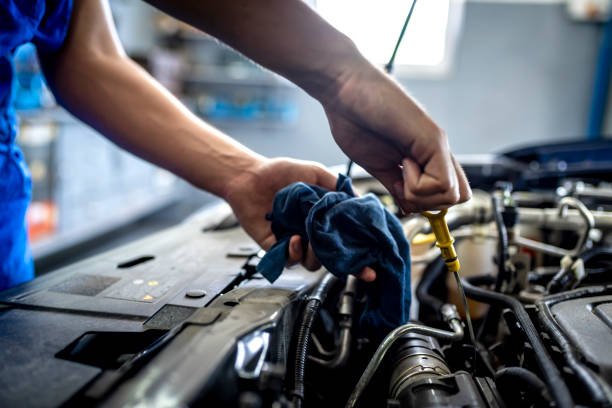Car repair and maintenance can be overwhelming for even the savviest of car owners. With so many steps to remember and more advanced systems to learn about, it can be difficult to stay on top of it all. That’s why we’ve created this comprehensive guide to car repair and maintenance. We’ll cover all the basics, from checking your engine oil to changing your brakes, and provide detailed instructions for each step. We’ll also go over some more advanced topics, such as diagnosing and fixing engine problems, and even some preventative maintenance tips to help you keep your car running smoothly for years to come. You don’t have to be a master mechanic to understand your car – this guide will help you learn everything you need to know.
Basics of Car Maintenance
Proper car maintenance is essential to ensure that your vehicle runs smoothly and efficiently for years to come. Here are some basic car maintenance tips to help you keep your vehicle in good condition:
- Regularly Check Fluid Levels: Your car needs several different types of fluids to function properly, including oil, coolant, brake fluid, transmission fluid, and power steering fluid. Check these fluids regularly and add more as needed.
- Change Oil Regularly: Your car’s engine needs clean oil to function properly. Change your car’s oil regularly as per the manufacturer’s recommendations.
- Check Your Tires: Check your tire pressure regularly and ensure they are properly inflated. Also, check the tire treads for wear and tear, and replace them as necessary.
- Replace Air Filter: A dirty air filter can reduce fuel efficiency and affect engine performance. Check and replace your car’s air filter as recommended by the manufacturer.
- Check the Brakes: Regularly check your car’s brakes and replace brake pads and rotors when needed.
- Keep the Battery Charged: A dead battery can be a major inconvenience. Check your car’s battery regularly and replace it if necessary.
- Keep the Car Clean: Regularly washing your car helps to prevent rust and keeps it looking new.
- Follow Manufacturer’s Maintenance Schedule: Your car’s manufacturer provides a maintenance schedule that outlines when to perform specific maintenance tasks. Follow this schedule to ensure that your car is properly maintained.
By following these basic car maintenance tips, you can help to ensure that your car runs smoothly and efficiently, and you can also prevent major problems from occurring.
Checking Your Engine Oil
Checking engine oil is an important part of basic car maintenance. Here are the steps to check your car’s engine oil:
- Make sure your car is parked on a level surface and the engine is turned off.
- Open the hood of your car and locate the dipstick. It is usually located near the front of the engine and has a brightly colored handle, typically yellow or orange.
- Remove the dipstick from the engine and wipe it clean with a cloth or paper towel.
- Re-insert the dipstick all the way back into the engine, making sure it is fully seated.
- Pull the dipstick back out and check the oil level. The dipstick will have two marks on it, one for the low level and one for the full level. The oil level should be between these two marks. If it is below the low mark, you need to add oil.
- Check the color and consistency of the oil on the dipstick. The oil should be a clear, amber color and have a smooth consistency. If the oil is dark, dirty, or gritty, it’s time for an oil change.
- If you need to add oil, locate the oil filler cap and add the recommended type of oil for your car. It’s important not to overfill the engine with oil.
- Once you have added oil, re-check the oil level using the dipstick and make sure it’s within the recommended range.
Regularly checking your car’s engine oil can help ensure that it is properly lubricated, which can prevent engine damage and extend the life of your vehicle.
How to Change Your Brakes
Replacing the brakes on your car can be a complex process, and if you are not confident in your ability to do it yourself, it’s best to have a professional mechanic handle it. However, if you are experienced in basic car maintenance and feel confident in your abilities, here are the general steps for changing the brakes on your car:
- Gather the necessary tools and parts. You will need a jack, jack stands, lug wrench, C-clamp, brake cleaner, new brake pads, new rotors (if needed), and a brake pad lubricant.
- Loosen the lug nuts on the wheel where you will be replacing the brakes.
- Use the jack to lift the car and place it on jack stands.
- Remove the lug nuts and the wheel.
- Locate the brake caliper, which is the part that holds the brake pads in place. Use a C-clamp to compress the caliper piston back into its housing.
- Remove the caliper bolts and slide the caliper off of the rotor.
- Remove the old brake pads from the caliper.
- Use brake cleaner to clean the caliper, rotor, and surrounding area.
- Apply brake pad lubricant to the back of the new brake pads.
- Install the new brake pads into the caliper.
- If you are replacing the rotors, remove the old rotor and install the new one.
- Reinstall the caliper and tighten the bolts.
- Replace the wheel and lug nuts.
- Lower the car to the ground and use a lug wrench to tighten the lug nuts.
- Repeat the process for the other wheels.
- Once you have completed the brake replacement on all four wheels, start the car and pump the brakes a few times to ensure they are working correctly.
It’s important to follow the manufacturer’s instructions and torque specifications when replacing the brakes on your car to ensure that they are installed correctly and functioning properly.
Diagnosing and Fixing Engine Problems
Diagnosing and fixing engine problems can be a complex process, and if you are not experienced in basic car maintenance, it’s best to have a professional mechanic handle it. However, if you are experienced and feel confident in your abilities, here are some general steps for diagnosing and fixing engine problems:
- Identify the symptoms: Start by identifying the symptoms of the engine problem, such as unusual noises, vibrations, or loss of power.
- Check the basics: Check the oil level, coolant level, and air filter. These simple checks can often reveal the source of the problem.
- Use an OBD-II scanner: An OBD-II scanner is a diagnostic tool that can read the engine codes stored in your car’s computer. Use the scanner to retrieve the codes and identify the problem.
- Research the problem: Once you have identified the problem, research the symptoms and possible causes. This can help you narrow down the potential issues and find the right solution.
- Replace faulty parts: If you have identified a faulty part, such as a spark plug, fuel injector, or sensor, replace it with a new one.
- Clean or adjust parts: Sometimes, the problem can be caused by dirty or misaligned parts. Clean or adjust the parts as necessary to fix the problem.
- Check for leaks: Check for leaks in the engine, such as oil leaks or coolant leaks. Replace any faulty gaskets or seals.
- Check the timing: Timing problems can cause engine issues. Check the timing and adjust it as necessary.
- Test drive the car: After making repairs or adjustments, test drive the car to ensure that the problem has been resolved.
It’s important to follow the manufacturer’s instructions and use the appropriate tools and parts when diagnosing and fixing engine problems. If you are not confident in your abilities or the problem is complex, it’s best to have a professional mechanic handle it.

